Around the world, cities are growing and urban areas are becoming more densely populated — creating new opportunities and challenges for road mobility and safety.
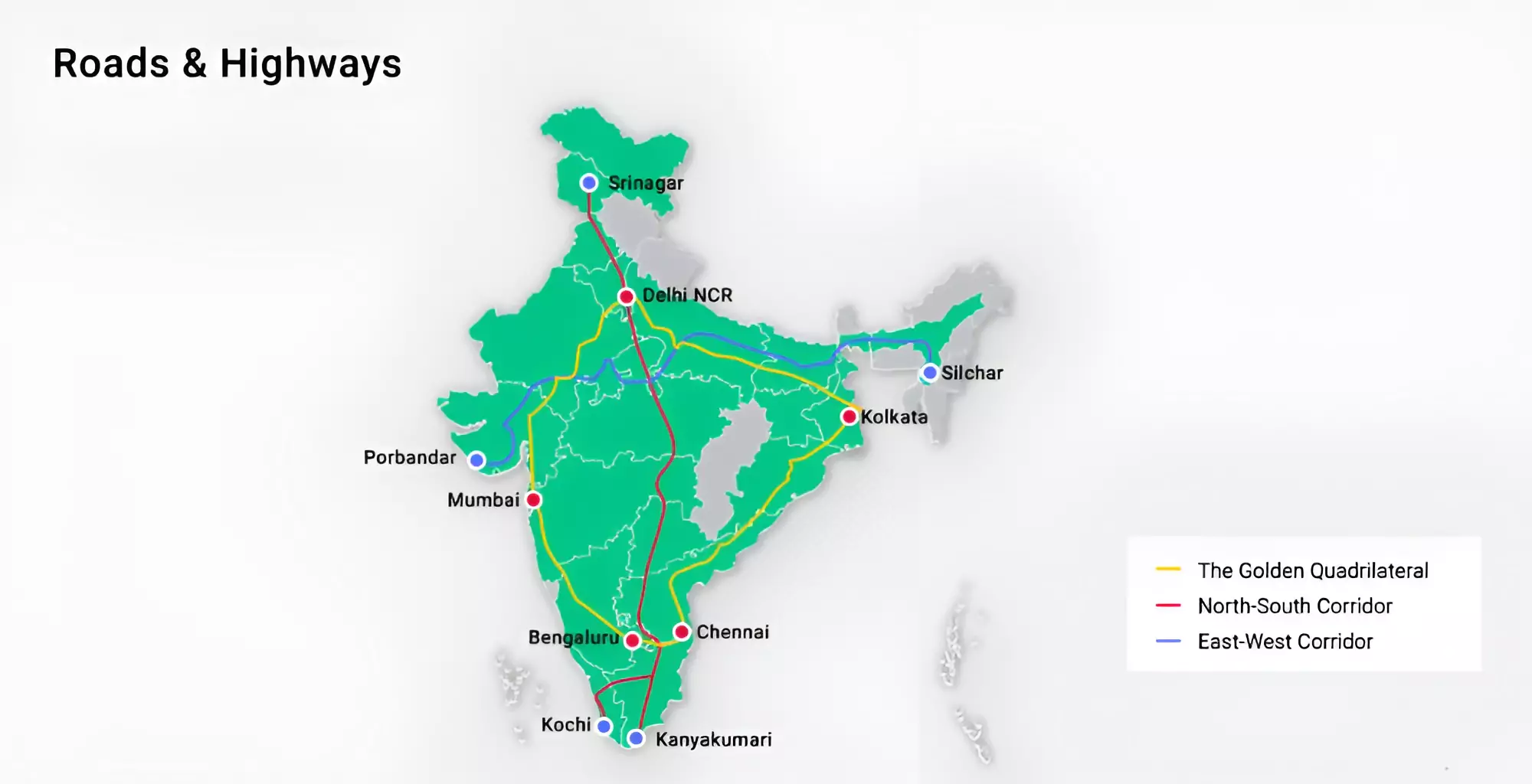
Road Infrastructure in India
- Road Network: India has the second largest road network in the world after the US, with about 66.71 lakh km of roads as of January 2024.
- India has significantly expanded its road infrastructure. India has a mere 5.13 km of road length per 1,000 people while China has a mere 3.6 km of roads per 1,000 people.The US has more than 20 km of road length per 1,000 people.
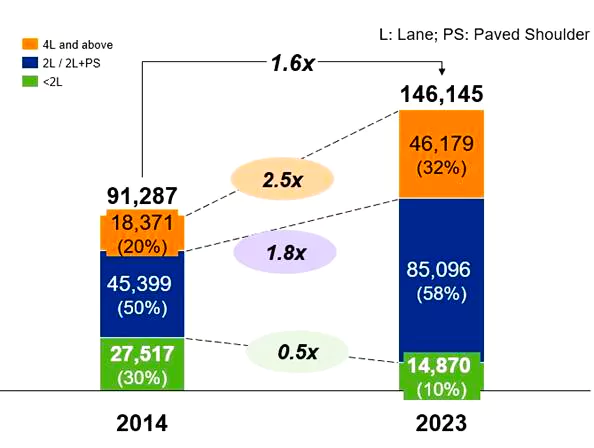 The length of various categories of roads is as under:
The length of various categories of roads is as under:
- National Highways: 1,46,145 km
- State Highways: 1,79,535 km
- Other Roads: 63,45,403 km
- Road Density: It is the length of road per 1000 sq. km of area and it varies across the country.
- In the fiscal year 2019, Chandigarh UT, has the highest road density in India, exceeding 22.6 thousand kilometers per one thousand square kilometers.
- Among states Kerala, ranks first with 6.7 thousand km per one thousand square kilometers.
- Budget Allocation: The annual budgetary allocation of the Union Ministry of Road Transport and Highways has been steadily increasing for the last several years, with the last year seeing a 25% jump.
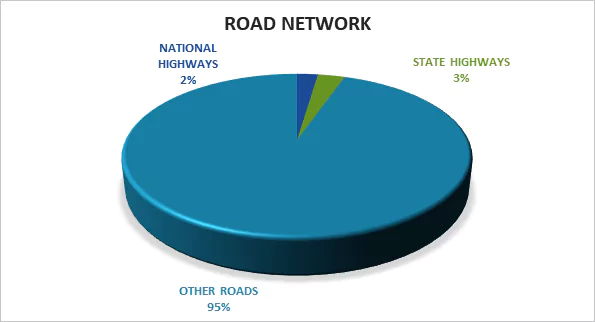 After revising the allocation for the previous year to ₹1.67 lakh crore, it is now ₹1.68 lakh crore for the 2024-25 fiscal year, benefiting the state-owned National Highways Authority of India (NHAI).
After revising the allocation for the previous year to ₹1.67 lakh crore, it is now ₹1.68 lakh crore for the 2024-25 fiscal year, benefiting the state-owned National Highways Authority of India (NHAI).- As per the ICRA, the Indian arm of the Fitch ratings agency, India is expected to maintain current road construction momentum, adding up to 13,000 kilometers in the 12 months through March 2025, an annual increase of 5-8%.
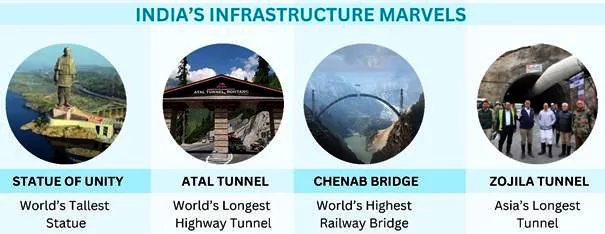 Employment Generation: A 10% increase in road infrastructure would lead to a 4.3% increase in employment directly and indirectly.
Employment Generation: A 10% increase in road infrastructure would lead to a 4.3% increase in employment directly and indirectly.- Foreign Direct Investment (FDI): 100% FDI in roads and highways is allowed under automatic route.
Enroll now for UPSC Online Course
- Mobility on Roads: It is a crucial aspect of modern society, enabling people to access essential services, engage in economic activities, and connect with others.
- The way roads are designed, built, and managed has a significant impact on people’s accessibility and mobility, safety, and the environment.
|
- Usage: Road transport carries about 87% of India’s total passenger traffic and more than 60% of its freight.
- Achievement: India has achieved significant milestones in infrastructure development, including the inauguration of the world’s longest highway tunnel, the Atal Tunnel, and the construction of the world’s highest railway bridge, the Chenab Bridge.
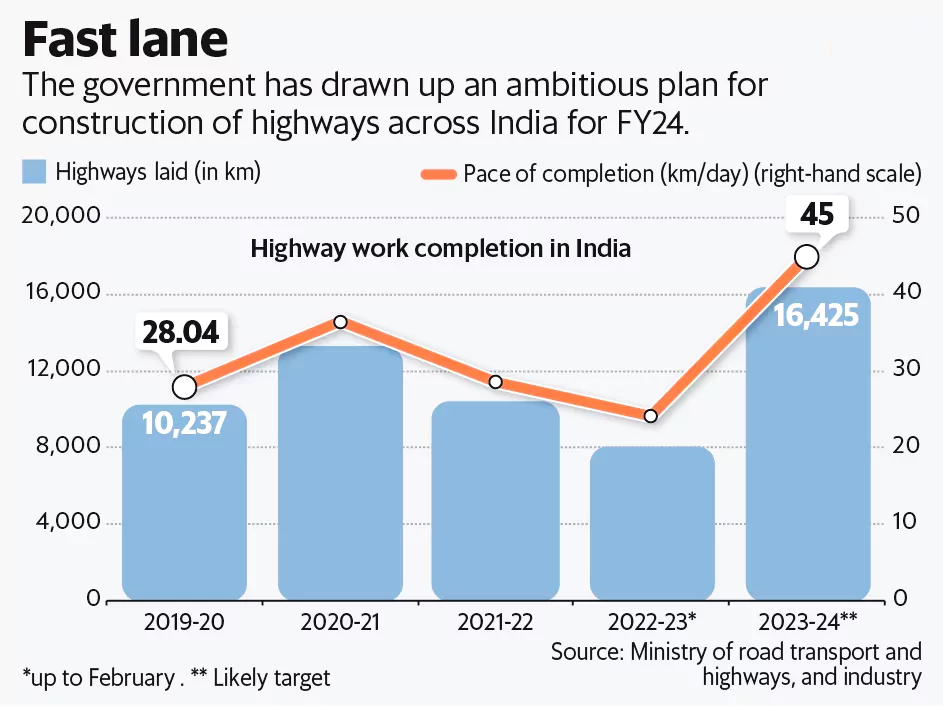
Government Initiatives for Improvement of Road Infrastructure in India
- Pradhan Mantri Gram Sadak Yojana (PMGSY): This project was initiated in 2001 to provide connectivity to unconnected Habitations as part of a poverty reduction strategy.
- Bharat New Car Assessment Programme: It has launched for safety rating of passenger cars and empowering consumers to take informed decisions
- PM Gati Shakti Scheme: It was inaugurated in 2021 and aims to ensure integrated planning and implementation of infrastructure projects in the next four years, with focus on expediting works on the ground, saving costs and creating jobs.
- Bharatmala Scheme: It aims to connect, improve and decongest the highways and road network of India. Bharatmala project map depicts the interconnected economic corridors, Inter corridors, feeder routes, Expressways and National Highways.
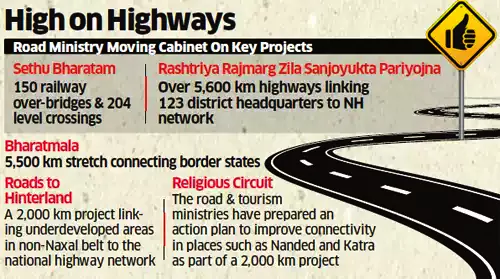 India Sustainable Mobility Initiative: To provide efficient mobility for the 200 million new urban dwellers expected by 2030 and mitigate the use of private vehicles and GHG emissions, India must achieve a dramatic increase in high quality rapid transit and improvements in walking and cycling infrastructure and urban development patterns.
India Sustainable Mobility Initiative: To provide efficient mobility for the 200 million new urban dwellers expected by 2030 and mitigate the use of private vehicles and GHG emissions, India must achieve a dramatic increase in high quality rapid transit and improvements in walking and cycling infrastructure and urban development patterns. - Delinking Road Development and Direct Employment: This resulted in labor intensive means of construction, putting a cap on the quality of roads. It was only in the late 90s when this mindset changed and the use of capital-intensive high-tech road making equipment was brought in.
- Creation of National Highways Authority of India (NHAI): It became operational in February 1995 to directly drive the development of National Highways.
- Creation of State-Level Road Development Corporations: With the creation of NHAI, many states also brought changes in their organizational structure for road development and delinked the state expressway projects from their Public Works Department (PWD). Maharashtra was the first state to set up the Maharashtra State Road Development Corporation Limited.
- National Highways Development Project (NHDP): It was started in 1998 and consequently grew to seven phases involving a total length of 49,260 km.
- In 2018, most of the NHDP was completed and the remaining works were subsumed under the larger Bharatmala Pariyojana.
- Focus on Rural Roads through Pradhan Mantri Gram Sadak Yojana (PMGSY): PMGSY has been one of the most successful projects in India. The success of PMGSY has also encouraged projects like the Mukhya Mantri Gram Sadak Yojana (MMGSY) in many states.
- Due to interventions like PMGSY, rural roads today constitute over 70% of the road infrastructure in India.
- Public-Private Partnerships (PPP) and Viability Gap Funding (VGF): PPP investments were increased through the introduction of financial/project models like the Viability Gap Funding (VGF) to reduce the financial risks of private players in road development.
- Evolution of the Model Concession Agreement (MCA): The first MCA for the road sector was brought in 2000 and has evolved over time for better allocation of risk between the PPP player and the development authorities.
- New Contracting Models and Asset Monetisation: Apart from the Classical tendering through the Engineering, Procurement and Construction (EPC) or the Build, Operate and Transfer (BOT), several new contracting models have emerged.
- Example: Hybrid Annuity Model (HAM) and Toll, Operate and Transfer (TOT) and the Infrastructure Investment Trusts (InVITs).
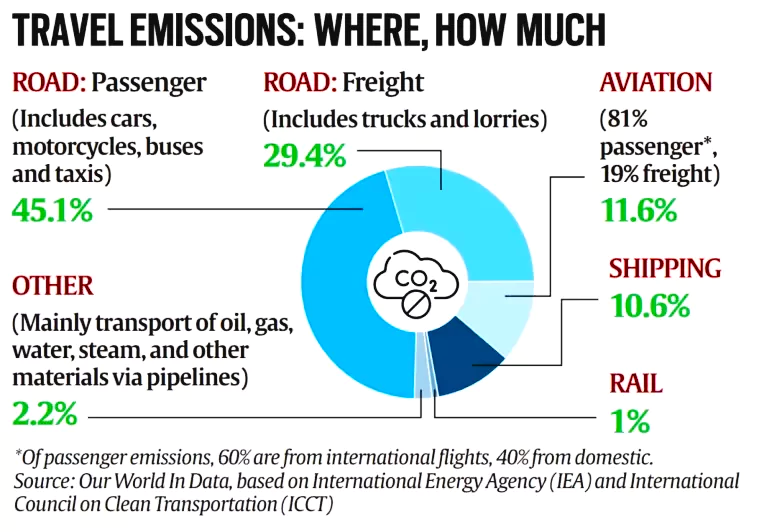 Technological Innovations:
Technological Innovations:-
- New Road Making Technologies: With the roll out of the NHDP, the import of the road-making equipment was brought under the open general license to ease their procurement process.
- Further, steps have been taken for enhanced Technology Transfer in the road making equipment.
- New and environmentally sustainable materials like fly ash, steel slag etc. are being used in road development.
- Introduction of Electronic Toll Collection (ETC): ETC has been introduced to reduce the toll collection time and traffic congestions at the toll Plazas.
Check Out UPSC CSE Books From PW Store
Challenges that Need to be Tackled
- Deteriorating Quality of Road Infrastructure: The deteriorating quality of existing road infrastructure results in more accidents, lower fuel efficiency and higher pollution.
- Driving smoothly in a range of 60-80 km per hour results in the best fuel efficiency.
- With commitment to achieve net-zero emissions by 2070, India has also committed to reduce its count of road-related accidents (which is among the highest in the world) accounting for 11% of global deaths every year in road mishaps—by about half by 2030.
|
-
- India’s intra-city vehicle speed is among the lowest in the world. The significantly reduced fuel efficiency at these speeds would result in more fossil-fuel burning and hence more greenhouse gas and other emissions that constitute air pollution.
- Environmental & Health Impact: The transport sector is a major contributor to global greenhouse gas emissions, at 14% of the total in 2018, as estimated, nearly four-fifths of it from road transport.
-
- The sector also accounts for a major proportion of urban air pollution; pollution-related deaths numbered 1.67 million in 2019. The road transport sector also contributes to mental stress and anxiety.
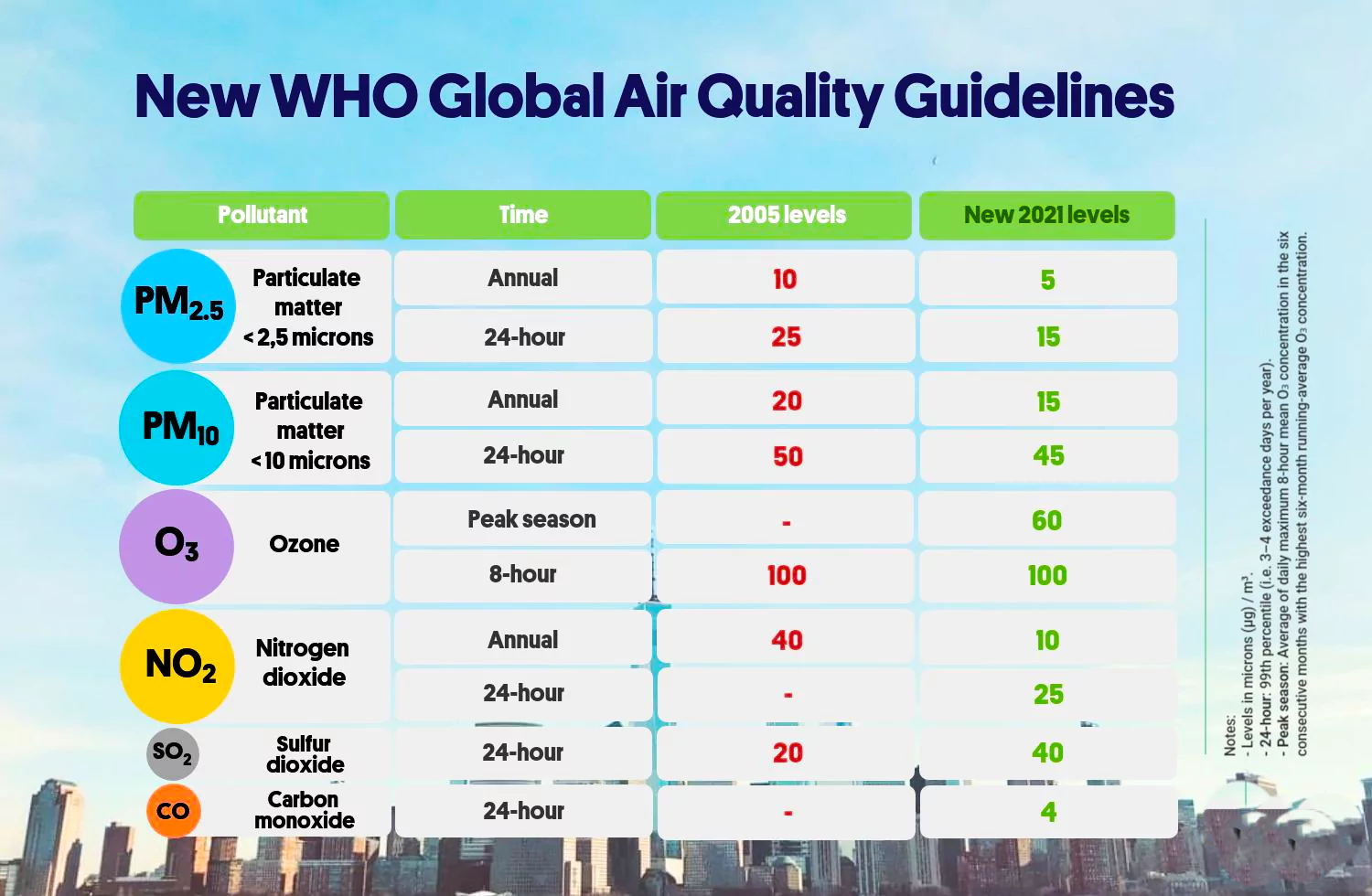 Of the 30 most polluted cities in the world, 21 were found to be in India in 2019.
Of the 30 most polluted cities in the world, 21 were found to be in India in 2019.
- Also, at least 140 million people in India—largely the poor—breathe air that is 10 times or more over the World Health Organization safe limit (with over a quarter of it caused by vehicles).
- Inadequate Attention to Design and Planning: Inadequate attention to the design, engineering and planning for road projects resulting in congestion and enormous environmental and resource impacts at every level.
- Example: The Delhi-Gurgaon and Dwarka Expressway are witnessing horrific accidents within months of inauguration involving pedestrians and smaller vehicles.
- As the investment plans did not find it necessary to provide any cross-over points for pedestrians or for smaller 2- and 3-wheeled vehicles.
- These projects are also prime examples of shifting choke-points.
- Road Capacity and Congestion: In terms of mobility demand management, there is a paradox of road transport. Capacity additions have to happen speedily just to stay in the same place and easing congestion gets harder as demand rises.
- Bengaluru, a Hub of Congestion is known as India’s Silicon Valley, grapples with severe traffic congestion, earning the 3rd position in the TomTom Traffic Index 2024 for metro regions.
- While toll charges for new expressways are a deterrent to trucks using these facilities, climate and air pollution concerns should have been driving these towards public and rail transportation modes.
- Also, de-bottlenecking attempts like odd-even schemes within cities merely result in higher ownership of vehicles.
- Neglect of Demand Management & Strategies: Industry and other associated stakeholders play an important role in demand management and unfortunately they continue to get a free pass at the expense of poorer commuters.
- However, a focus on demand management would be a much more cost- and environmental- effective way of providing mobility services.
- Lack of Focus on Safety: Lack of focus on road designs and construction practices are the biggest causes of unsafe roads in India.
- Lack of buffer lanes, low number of crash barriers, lack of scientific signage, etc., are few unsafe practices.
- Lack of Origin to Destination (OD) Data: There is lack of use of OD data (means traffic flow data while planning the road development projects).
- The OD data must be integrated with the Electronic Toll Collection (ETC).
- Less Attention to Urban Roads: India’s urban roads have not been getting enough attention as the rural roads. This results in low speeds in ban areas, leading to significant wastage of time and poor first/last mile connectivity.
- Further, urban goods movement is treated poorly, parking is a significant issue and also there are coordination issues with urban public transport.
- Disputes with the PPP Players & the Authority: Significant time and energy is wasted in disputes between the PPP players and the authority.
- There are two-lane highways waiting to be made into four-lanes but cannot proceed due to contractual conflicts. Projects get delayed, leading to significant user inconvenience.
Enroll now for UPSC Online Classes
Way Forward
- Ensuring Safe Road Designs: There is a need to ensure that the road designs are compatible with the Indian Roads Congress Standards.
- Also the material testing facilities must be enhanced at the construction site.
- Use of Innovative Technology: Use of technologies like sensors are required to monitor traffic flows, intelligent transport systems and smart road infrastructure will improve the road safety and efficiency.
- Focus on Road Maintenance: The government needs to prioritize regular maintenance of roads like resurfacing, pothole filling and drainage system maintenance.
- Rise in Investment: The government needs to explore options like road bonds, green bonds for highway development.
- The sector should be made financially lucrative to draw maximum FDI inflows.
- Incorporation of Lane Capacity Measurement while Measuring Road Capacity: As more and more multiple-lane roads get constructed, it is important to focus on the measurement of lane kilometers rather than road kilometers.
- Increased Public-Private Partnerships (PPPs): It is desirable and required to finance, design, construct, and operate infrastructure projects.
- Effective Regulation: The government can establish and enforce effective regulations to ensure the quality and safety of infrastructure projects.
- Regulations can set standards for the quality of materials, safety requirements, such as fire safety, evacuation plans, and accessibility standards that ensure the safety of the public and the workers involved in the project.
- Independent inspection and testing should be done in an effective and strict manner.
- Regulations should be followed in terms of environment point of view such as adoption of more e-vehicles (Bharat series (BH-series) of vehicle registration), enhancement in Type Approval of Compressed Gaseous Hydrogen Internal Combustion Engine Vehicles and strict punishment on violation of regulations.
- Time for Sustainable Transformation by adopting Cycling:
- Reduction in Traffic Congestion: The number of cars on the road is declining as more people choose to ride bicycles and hence travel times and congestion will reduce with the improved traffic flow.
- Reduction in Harmful Emissions: Bicycles have no emissions and would be a better, cleaner, and healthier option.
- Cycling is a great way to increase cardiovascular health, reduce the risk of developing chronic illnesses like diabetes and obesity, and enhance mental health too.
- Space Efficiency: Even in terms of space requirement, bicycles are far more efficient as it liberates significant space for parks, pedestrian areas, or infrastructure related to public transportation.
- The Netherlands is recognized worldwide as a leading cycling-friendly country.
- Adopting the first pan-European Master Plan for Cycling Promotion in 2021, it set a historic milestone for Europe on the way to a climate neutral mobility system.
- As per the Master Plan, cycling brings a triple benefit to societies: boosting the local economy with more green jobs, increasing people’s health and actively protecting the climate.
Check Out UPSC NCERT Textbooks From PW Store
![]() 6 Jun 2024
6 Jun 2024
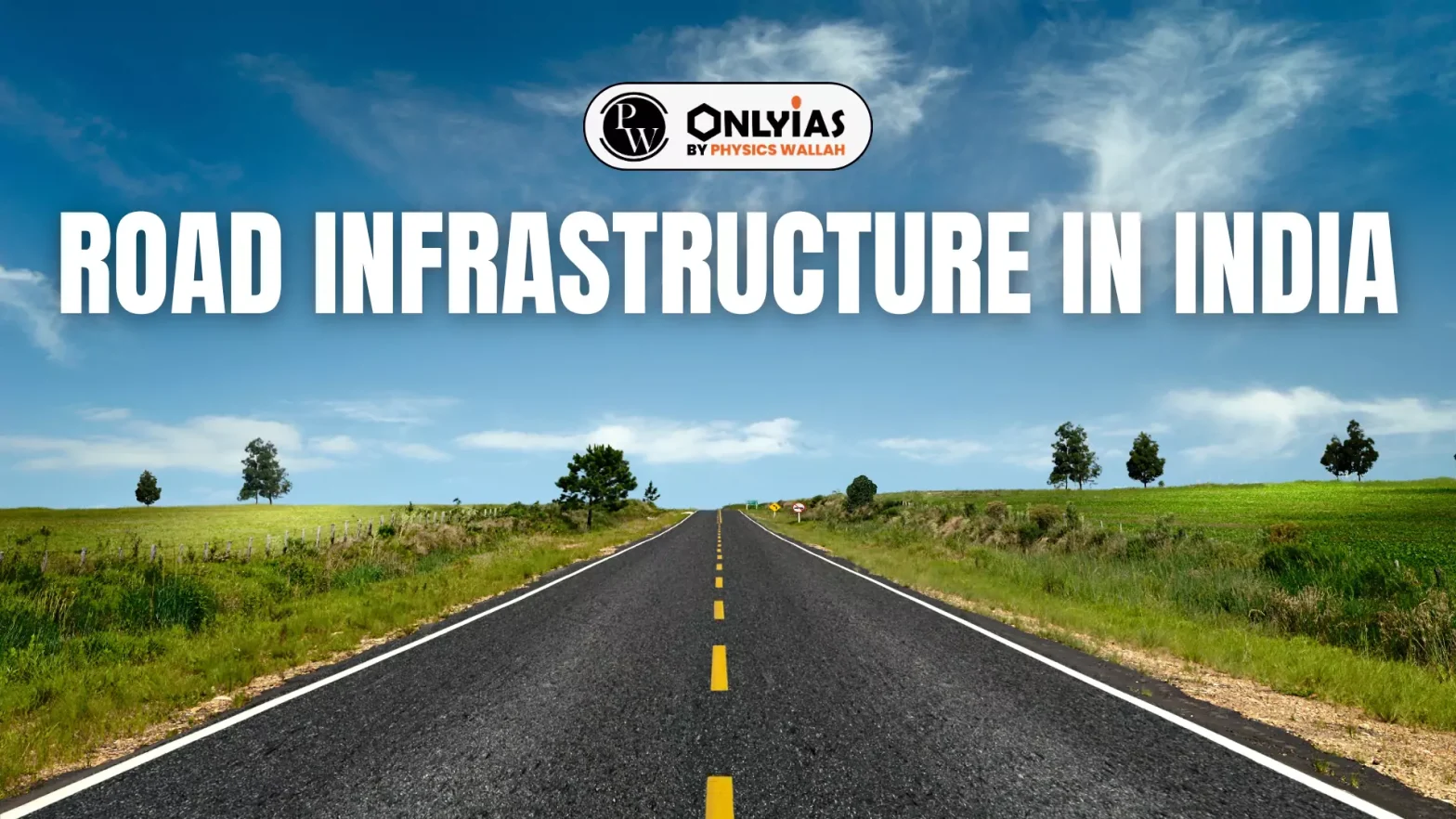

 The length of various categories of roads is as under:
The length of various categories of roads is as under:
 After revising the allocation for the previous year to ₹1.67 lakh crore, it is now ₹1.68 lakh crore for the 2024-25 fiscal year, benefiting the state-owned National Highways Authority of India (NHAI).
After revising the allocation for the previous year to ₹1.67 lakh crore, it is now ₹1.68 lakh crore for the 2024-25 fiscal year, benefiting the state-owned National Highways Authority of India (NHAI). Employment Generation: A 10% increase in road infrastructure would lead to a 4.3% increase in employment directly and indirectly.
Employment Generation: A 10% increase in road infrastructure would lead to a 4.3% increase in employment directly and indirectly.
 India Sustainable Mobility Initiative: To provide efficient mobility for the 200 million new urban dwellers expected by 2030 and mitigate the use of private vehicles and GHG emissions, India must achieve a dramatic increase in high quality rapid transit and improvements in walking and cycling infrastructure and urban development patterns.
India Sustainable Mobility Initiative: To provide efficient mobility for the 200 million new urban dwellers expected by 2030 and mitigate the use of private vehicles and GHG emissions, India must achieve a dramatic increase in high quality rapid transit and improvements in walking and cycling infrastructure and urban development patterns.  Technological Innovations:
Technological Innovations: Of the 30 most polluted cities in the world, 21 were found to be in India in 2019.
Of the 30 most polluted cities in the world, 21 were found to be in India in 2019.